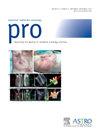放射外科协会 GRID、LATTICE、微束和 FLASH 放射治疗工作组:2022 - 2023 年进展研讨会及后续进展。
IF 3.5
3区 医学
Q2 ONCOLOGY
引用次数: 0
摘要
目的:自美国国家癌症研究中心(NCI)主办、放射外科协会(RSS)赞助的 "了解大剂量、超高剂量率和空间分割放射治疗 "首届研讨会以来,专家、从业人员和研究人员之间的合作和调查日益增多。RSS GRID、Lattice、Microbeam & FLASH(GLMF)工作组是作为这些工作的框架而成立的,其工作重点是促进对这些新放射治疗模式的生物学、技术/物理参数、试验设计和临床实践的理解:鉴于临床对 SFRT 和 FLASH 的兴趣稳步增长,2022 年,在 RSS 科学会议召开前夕,举办了题为 "GRID、LATTICE 和 FLASH 放射治疗进展研讨会 "的全天研讨会。此次研讨会出席人数众多,重点讨论了 SFRT 的临床、技术和物理方法,同时仔细研究了相关的放射生物学基础。实际临床试验开发是讨论的重点。另外,会议还回顾了质子治疗和其他基于粒子的技术,以提供 GRID 和 Lattice 治疗。GRID、LATTICE和质子GRID/LATTICE的治疗计划和实施教程针对的是开发新的临床GRID或LATTICE计划的实际考虑因素。对 FLASH 的讨论也采用了类似的方法。本报告总结了第一届GLMF研讨会的内容以及RSS GLMF工作组在异质和超高剂量率辐照领域大约两年的相关工作:结果:随着使用 SFRT 和 FLASH 的机构和从业人员数量不断增加,GLMF 工作组的成员和出席人数持续增加,并随之产生了一些试验概念、研究工作、学术讨论和同行评审出版物:结论:GLFM 工作组和 RSS 在推广使用 SFRT 和超高剂量率放射治疗技术并提高对其的认识方面继续取得卓越进展。本文章由计算机程序翻译,如有差异,请以英文原文为准。
The Radiosurgery Society Working Groups on GRID, LATTICE, Microbeam, and FLASH Radiotherapies: Advancements Symposium and Subsequent Progress Made
Purpose
Since the inaugural workshop “Understanding High-Dose, Ultra-High Dose Rate and Spatially Fractionated Radiotherapy.” hosted by the National Cancer Institute and sponsored by the Radiosurgery Society (RSS), growing collaborations and investigations have ensued among experts, practitioners, and researchers. The RSS GRID, LATTICE, Microbeam and FLASH (GLMF) Working Groups were formed as a framework for these efforts and have focused on advancing the understanding of the biology, technical/physical parameters, trial design, and clinical practice of these new radiation therapy modalities.
Methods and Materials
In view of the steadily increasing clinical interest in Spatially Fractionated Radiotherapy (SFRT) and FLASH, a full-day symposium entitled “Advancements in GRID, LATTICE, and FLASH Radiotherapy Symposium” was established in 2022 that immediately preceded the RSS scientific meeting. This well-attended symposium focused on clinical, technical, and physics approaches for SFRT, and closely examining relevant radiobiological underpinnings. Practical clinical trial development was a highlighted discussion. An additional section reviewed proton therapy and other particle-based techniques for the delivery of GRID and LATTICE therapy. A treatment planning and delivery tutorial for GRID, LATTICE, and proton GRID/LATTICE was directed toward the real-world considerations for the development of new clinical GRID or LATTICE programs. An overall similar approach was applied to the discussion of FLASH. This report summarizes the content of the first GLMF Symposium and related work of the RSS GLMF Working Groups in the field of heterogeneous and ultrahigh dose rate irradiation, over approximately 2 years.
Results
The GLMF Working Groups have continued to expand in membership and attendance, and several resultant trial concepts, research efforts, academic discussions, and peer-reviewed publications have followed as the number of institutions and practitioners using SFRT and FLASH continues to grow.
Conclusions
The GLMF Working Groups and the RSS continue to demonstrate excellent progress in proliferating use of and improving understanding of SFRT and ultrahigh dose rate radiation therapy techniques.
求助全文
通过发布文献求助,成功后即可免费获取论文全文。
去求助
来源期刊

Practical Radiation Oncology
Medicine-Radiology, Nuclear Medicine and Imaging
CiteScore
5.20
自引率
6.10%
发文量
177
审稿时长
34 days
期刊介绍:
The overarching mission of Practical Radiation Oncology is to improve the quality of radiation oncology practice. PRO''s purpose is to document the state of current practice, providing background for those in training and continuing education for practitioners, through discussion and illustration of new techniques, evaluation of current practices, and publication of case reports. PRO strives to provide its readers content that emphasizes knowledge "with a purpose." The content of PRO includes:
Original articles focusing on patient safety, quality measurement, or quality improvement initiatives
Original articles focusing on imaging, contouring, target delineation, simulation, treatment planning, immobilization, organ motion, and other practical issues
ASTRO guidelines, position papers, and consensus statements
Essays that highlight enriching personal experiences in caring for cancer patients and their families.
 求助内容:
求助内容: 应助结果提醒方式:
应助结果提醒方式:


